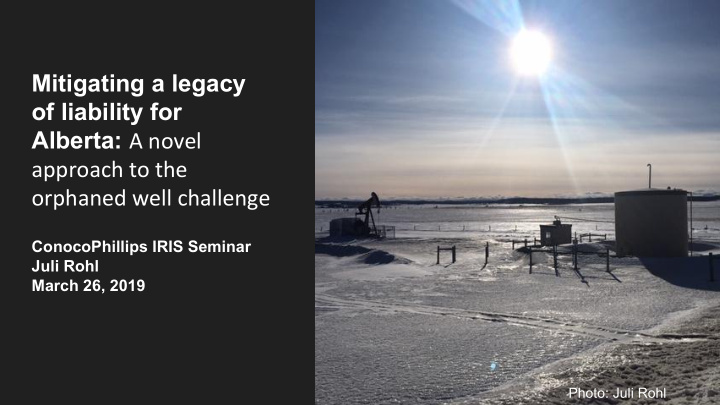



Mitigating a legacy of liability for Alberta: A novel approach to the orphaned well challenge ConocoPhillips IRIS Seminar Juli Rohl March 26, 2019 Photo: Juli Rohl
Agenda Truth and Reconciliation Commission call to action What is the Liability problem? Why does this problem exist? Redwater Energy Supreme court case The opportunities for innovation
Read the Truth and Reconciliation ★ Commission of Canada Report - including the 94 calls to action Read the United Nations Declaration ★ on the rights of Indigenous People Connect on a human level ★
Exploration & Drilling Reclaim Lifecycle of a well Abandon Production Decline / Sell
Liabilities in Alberta’s oil and gas industry are accumulating very rapidly
Where are the inactive wells in Alberta? Jan 5, 2019 Source: Fuzeium 89,461
Inactive wells in Alberta Source: Alberta Energy Regulator Area Based Closure Presentation
Properly addressing liabilities is extremely expensive
Companies go bankrupt and leave their liabilities behind
Source: Orphan Well Association response to Redwater Decision
Source: Orphan Well Association
We’ve drilled a LOT of wells in Alberta
122,421 Wells “closed”
481,957 Wells with closure work yet to do
how did we get here?
Past approaches to liability management Bury Dig and dump Suspension Reactivation Timelines
LLR Liability Assets Management = Rating (LMR) Liabilities Licensee Liability Rating Industry Average LMR: Program 4.85 Directive 006
February, 2019 LMR=0 222
The Redwater Energy Supreme Court Case ?
“Bankruptcy is not a licence to ignore rules, and insolvency professionals are bound by and must comply with valid provincial laws during bankruptcy,” Chief Justice Richard Wagner Link to case in brief
- Fewer liabilities sent to the Orphan Well Association - Eliminates the ability of companies to Implications of the dump liabilities into a shell company and bankrupt it Redwater Energy - Confirms that environmental obligations need to be honoured as part of Decision bankruptcy proceedings. - Lenders may be more prudent in examining end of life obligations
CAPP (Canadian AER (Alberta ATB Financial What does Association of Energy everyone "It was important for Petroleum Regulator) us to get clarity on Producers) think about what the “We are pleased “CAPP believes that interpretation of the this? that the Supreme this judgment law was, to ensure Court recognized restores the balance that we could have the potential between the right approach massive impacts environmental in balancing the that this issue could obligations and environment and have caused – not creditor interests to the economics," just for the energy that which existed sector— but for "ATB will continue for many years many industries to support the before this case.” across the country.” energy industry.”
CAPP (Canadian AER (Alberta ATB Financial What does Association of Energy everyone "It was important for Petroleum Regulator) us to get clarity on Producers) think about what the “We are pleased “CAPP believes that interpretation of the this? that the Supreme this judgment law was, to ensure Court recognized restores the balance that we could have the potential between the right approach massive impacts environmental in balancing the that this issue could obligations and environment and have caused – not creditor interests to the economics," just for the energy that which existed sector— but for "ATB will continue for many years many industries to support the before this case.” across the country.” energy industry.”
CAPP (Canadian AER (Alberta ATB Financial What does Association of Energy everyone "It was important for Petroleum Regulator) us to get clarity on Producers) think about what the “We are pleased “CAPP believes that interpretation of the this? that the Supreme this judgment law was, to ensure Court recognized restores the balance that we could have the potential between the right approach massive impacts environmental in balancing the that this issue could obligations and environment and have caused – not creditor interests to the economics," just for the energy that which existed sector— but for "ATB will continue for many years many industries to support the before this case.” across the country.” energy industry.”
What are the possible solutions to this problem?
Legislation And Regulation
Timelines
Area Based Closure
Our mission is to ReGenerate Alberta's economy and put people back to work by finding the value in what's being left behind by the oil and gas industry
How can we create value?
from this: to this:
Possible transitions for mature oil and gas infrastructure EDIBLE FOREST COMMUNITY RESIDENTIAL GARDEN WETLAND (COMMUNITY) FOREST TRAP LINES WILDLIFE GREENHOUSE REHABILITATIO GEOTHERMAL LANDFILL LAKE N AREA ATHLETIC GOAT YOGA FIELD RIG TO LITHIUM CULTURAL INTERPRETIVE REEF DOG PARK CENTRE AREA CAMPGROUND MOUNTAIN WIND BIKE PARK RV / BOAT FARM CABINS VERTICAL PLAYGROUND STORAGE FARMING SOLAR PAINTBALL CCS FARM TRAINING FACILITY FACILITY RESEARCH FACILITY LEAST COMPLEX ------------- MOST COMPLEX
Additional sources of revenue Expected benefits from repurposing Extend timeframe for reclamation obligations - oil and gas increases remediation options. Bio-remediation etc. infrastructure Reduces the amount of greenfield and agricultural land use for renewable energy projects Engages and Empowers the community and landowners Create forward looking plans at time of development.
A BIG IDEA
Made with technology from:
Conversation Juli Rohl jrohl@regenerateab.ca
DEFINITIONS Active wells: wells that are currently producing oil or natural gas. Inactive wells: wells that have not produced oil or natural gas in six to twelve months, depending on the type of well. Suspended wells: wells on which operations have been inactive for more than six or twelve months, depending on the type of well. Abandoned wells: wells that are plugged permanently by removing the tubing and filling the wellbore with concrete. Orphaned wells: wells that no longer have an identifiable owner. Reclaimed wells: well sites that are properly abandoned and the habitat around the well returned to its original land use capability. Remediation: Cleaning up the impacts to soil or groundwater to an acceptable level. Reclamation : Restoring the soil and vegetation to support the original land use capability of the site.
Recommend
More recommend